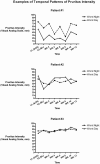A longitudinal study of uremic pruritus in hemodialysis patients
- PMID: 20558560
- PMCID: PMC2924419
- DOI: 10.2215/CJN.00100110
A longitudinal study of uremic pruritus in hemodialysis patients
Abstract
Background and objectives: Although uremic pruritus (UP) is a highly prevalent complication of chronic kidney disease, it remains poorly characterized. There have been no longitudinal studies of natural history, and no health-related quality of life (HR-QOL) instruments have been developed for UP. The objectives of this study were to describe the natural history of UP, to compare rating scales of itching intensity, and to assess usefulness and validity of HR-QOL instruments for UP.
Design, setting, participants, & measurements: The intensity, severity, and effects of pathologic itching on HR-QOL were assessed prospectively in 103 patients with UP on chronic hemodialysis. Outcome measures were obtained at scheduled intervals over 3.5 months.
Results: Itching daily or nearly daily was reported by 84% of patients and had been ongoing for >1 year in 59%. In 83%, pruritus involved large, nondermatomal areas with striking bilateral symmetry. Two thirds of the patients were using medications such as antihistamines, steroids, and various emollients without satisfactory relief of itching. Statistically significant associations were found among itching intensity, severity, and HR-QOL measures in domains such as mood, social relations, and sleep. Among patients with moderate-to-severe UP, changes in itching intensity of 20% or greater were associated with significant reductions in HR-QOL measures.
Conclusions: This first longitudinal study of UP describes key features of UP and its effect on HR-QOL. The assessment instruments we have developed are easily used, are responsive to changes in UP intensity, and should facilitate clinical evaluation and research to meet the needs of afflicted patients.
Figures







References
-
- Pisoni RL, Wikstrom B, Elder SJ, Akizawa T, Asano Y, Keen ML, Saran R, Mendelssohn DC, Young EW, Port FK: Pruritus in haemodialysis patients: International results from the Dialysis Outcomes and Practice Patterns Study (DOPPS). Nephrol Dial Transplant 21: 3495–3505, 2006 - PubMed
-
- Ikoma A, Rukwied R, Stander S, Steinhoff M, Miyachi Y, Schmelz M: Neurophysiology of pruritus: Interaction of itch and pain. Arch Dermatol 139: 1475–1478, 2003 - PubMed
-
- Bhaduri S, Mathur V, Fellmann J, Rosen D: Uremic pruritus patients: A national survey of sleep and mood disruptions [Abstract]. Am J Kidney Dis 49: B31, 2007
-
- Dar NR, Akhter A: Clinical characteristics of uremic pruritus in patients undergoing haemodialysis. J Coll Physicians Surg Pak 16: 94–96, 2006 - PubMed
-
- Szepietowski JC, Szepietowski T, Reich A: Efficacy and tolerance of the cream containing structured physiological lipids with endocannabinoids in the treatment of uremic pruritus: A preliminary study. Acta Dermatovenerol Croat 13: 97–103, 2005 - PubMed
Publication types
MeSH terms
Substances
LinkOut - more resources
Full Text Sources
Medical

